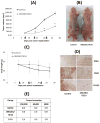Small-Molecule ONC201/TIC10 Targets Chemotherapy-Resistant Colorectal Cancer Stem-like Cells in an Akt/Foxo3a/TRAIL-Dependent Manner
- PMID: 25712124
- PMCID: PMC4537643
- DOI: 10.1158/0008-5472.CAN-13-3451
Small-Molecule ONC201/TIC10 Targets Chemotherapy-Resistant Colorectal Cancer Stem-like Cells in an Akt/Foxo3a/TRAIL-Dependent Manner
Abstract
Self-renewing colorectal cancer stem/progenitor cells (CSC) contribute to tumor maintenance and resistance to therapy. Therapeutic targeting of CSCs could improve treatment response and prolong patient survival. ONC201/TIC10 is a first-in-class antitumor agent that induces TRAIL pathway-mediated cell death in cancer cells without observed toxicity. We have previously described that ONC201/TIC10 exposure leads to transcriptional induction of the TRAIL gene via transcription factor Foxo3a, which is activated by dual inactivation of Akt and ERK. The Akt and ERK pathways serve as important targets in CSCs. Foxo3a is a key mediator of Akt and ERK-mediated CSC regulation. We hypothesized that the potent antitumor effect of ONC201/TIC10 in colorectal cancer involves targeting CSCs and bulk tumor cells. ONC201/TIC10 depletes CD133(+), CD44(+), and Aldefluor(+) cells in vitro and in vivo. TIC10 significantly inhibits colonosphere formation of unsorted and sorted 5-fluorouracil-resistant CSCs. ONC201/TIC10 significantly reduces CSC-initiated xenograft tumor growth in mice and prevents the passage of these tumors. ONC201/TIC10 treatment also decreased xenograft tumor initiation and was superior to 5-fluorouracil treatment. Thus, ONC201/TIC10 inhibits CSC self-renewal in vitro and in vivo. ONC201/TIC10 inhibits Akt and ERK, consequently activating Foxo3a and significantly induces cell surface TRAIL and DR5 expression in both CSCs and non-CSCs. ONC201/TIC10-mediated anti-CSC effect is significantly blocked by the TRAIL sequestering antibody RIK-2. Overexpression of Akt, DR5 knockdown, and Foxo3a knockdown rescues ONC201/TIC10-mediated depletion of CD44(+) cells and colonosphere inhibition. In conclusion, ONC201/TIC10 is a promising agent for colorectal cancer therapy that targets both non-CSCs and CSCs in an Akt-Foxo3a-TRAIL-dependent manner.
©2015 American Association for Cancer Research.
Conflict of interest statement
Figures





References
-
- Siegel R, Desantis C, Jemal A. Colorectal cancer statistics, 2014. CA Cancer J Clin. 2014;64(2):104–17. - PubMed
-
- Clevers H. The cancer stem cell: premises, promises and challenges. Nat Med. 2011;17(3):313–9. - PubMed
-
- Ricci-Vitiani L, Lombardi DG, Pilozzi E, Biffoni M, Todaro M, Peschle C, et al. Identification and expansion of human colon-cancer-initiating cells. Nature. 2007;445(7123):111–5. - PubMed
-
- O’Brien CA, Pollett A, Gallinger S, Dick JE. A human colon cancer cell capable of initiating tumour growth in immunodeficient mice. Nature. 2007;445(7123):106–10. - PubMed
Publication types
MeSH terms
Substances
Grants and funding
LinkOut - more resources
Full Text Sources
Other Literature Sources
Medical
Research Materials
Miscellaneous

